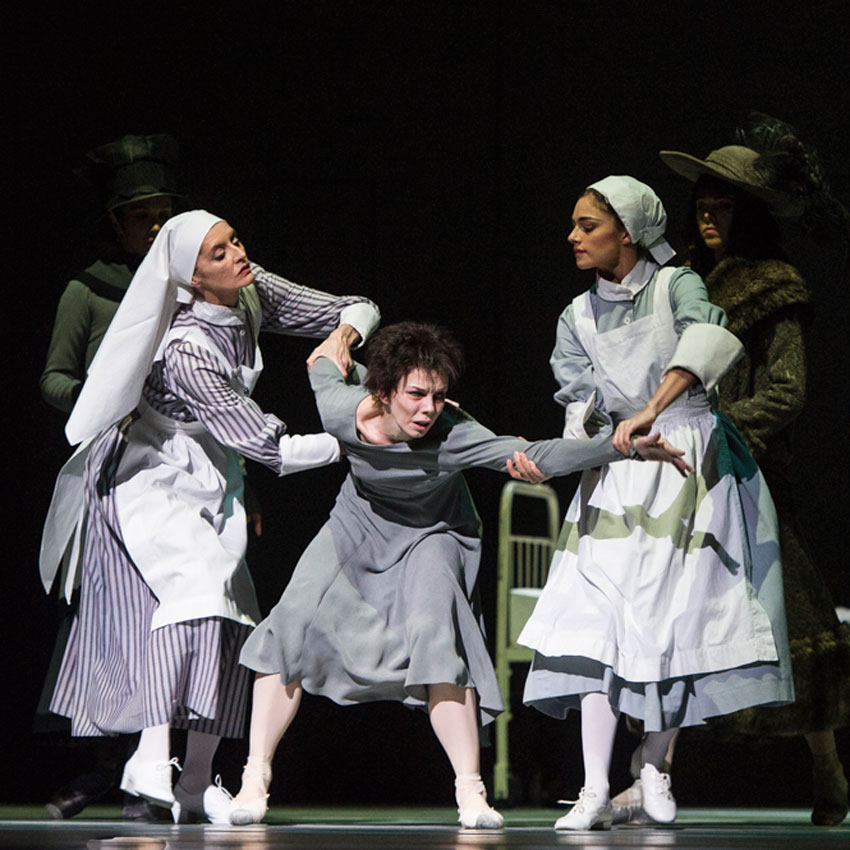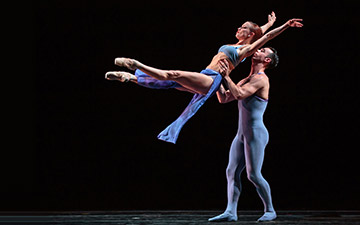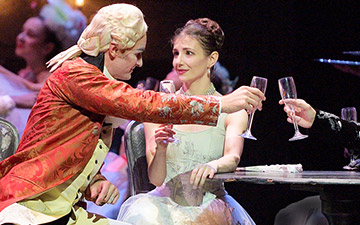
© Foteini Christofilopoulou, courtesy the Royal Opera House. (Click image for larger version)
Part of the Royal Opera House #OurHouseToYourHouse series available until 28 May 2020
The Royal Ballet
Anastasia
★★★★✰
Streamed archive recording of 2016 performance at London’s Royal Opera House
Relay 15 May 2020
Interview with Gary Harris including a section on setting Kenneth MacMillan’s Anastasia on the Royal Ballet
Gallery of pictures by Foteini Christofilopoulou
www.roh.org.uk/tickets-and-events/anastasia-stream-details
www.roh.org.uk/streaming
roh.org.uk
Sir Kenneth MacMillan’s full-length production of Anastasia was created for The Royal Ballet (RB) in 1971. A one-act ballet, which was eventually to become the third act, had been created prior to this for the Deutsche Oper Ballett in Berlin in 1967 (with Lynn Seymour in the title role). More than fifty years later, the final act looks completely contemporary, reminding me of just how exciting it was when the RB first performed it. It is also a fantastic vehicle for the leading ballerina, requiring inherent dramatic ability.
Originally filmed for a live streaming in 2016, and directed by Ross MacGibbon, this is a fabulous opportunity to revisit a particularly strong cast. It is also a chance for those interested in the ill-fated Romanov family, Tsar Nicholas II, his wife Tsarina Alexandra Feodorovna and their four children, to discover the circumstances which led Anna Anderson to claim she was Anastasia. A birthmark on her hand (which is later referred to in Act III), similar to that of the Grand Duchess, furthered her assertion that she was the only surviving member of the family after they were brutally murdered on 17 July 1918, at Ekaterinburg. It has since been proved with DNA tests that Anderson was not a member of the Romanov family, but MacMillan’s compelling production may still persuade you otherwise. At the very least, it is a sumptuous, beautifully dressed ballet with superb sets (re-designed by Bob Crowley in 1996) and while I miss the rich blues of the Tsarina and her daughters’ diaphanous, floating ball gowns in the second act (Barry Kay was the original designer) – Crowley’s designs are magnificent.

© Foteini Christofilopoulou, courtesy the Royal Opera House. (Click image for larger version)
Natalia Osipova is ideally cast as Anastasia. She first appears on roller skates in a playful dance, helped along by a band of attentive officers and her three older sisters. The atmosphere is positive and joyous, and while the action is clear, the stage is nevertheless filled with a great deal of exceptionally challenging choreography. Three leading officers have solos (Ryoichi Hirano, Valeri Hristov and Alexander Campbell respectively) which require a large dose of technical virtuosity. All prove excellent though Campbell has the edge not only because he starts with six, perfectly executed pirouettes and some beautiful, high jumps but he is simply so dashing. Wonderful to see how seamlessly this sequence leads into some lovely dancing for the sisters Olga (Olivia Cowley), Tatiana (Beatriz Stix-Brunell) and Marie (Yasmine Naghdi), all displaying superb ballon, control and balance alongside a tangible warmth and sisterly love. I was particularly taken with Cowley whose joie de vivre or concern regarding her haemophiliac brother, translated beautifully on the screen. One hardly registers ‘steps’ with Osipova for she seems to skim the surface of the stage before taking flight effortlessly. She teases rather than flirts with the officers dancing mainly with Edward Watson (charm personified) and later with another trio of officers clad in bathing suits – another tricky pas de trois which does not faze the likes of Tristan Dyer, Marcelino Sambé and Luca Acri.
Christopher Saunders and Christina Arestis are gracious as the Tsar and Tsarina and the diminutive Rory Toms is most appealing as the Tsarevitch Alexey (much better to cast a young lad in this role rather than a small female company member, as it was originally). His fall, which causes so much consternation and worry to his family is creepily dealt with by Rasputin (a very sinister-looking Thiago Soares) but Rasputin’s healing of the injured boy is a good piece of theatre, establishing how heavily influenced the Tsarina and Grand Duchesses were by his brooding presence. With the arrival of a telegram and news of unrest, the mood becomes increasingly sombre, but the ensemble of soldiers marching off to meet their fate is a lesson in military precision that concludes the act with a sense of urgency.

© Foteini Christofilopoulou, courtesy the Royal Opera House. (Click image for larger version)
The grandeur of the second act is even more of a spectacle with Crowley’s skewed chandeliers dominating the set. At a ball celebrating Anastasia’s coming out to society, it serves all aspects of the unfolding story. Guests at the ball include the ballerina Mathilde Kschessinska and her unnamed partner (Marianela Nuñez and Federico Bonelli). Kschessinska was purported to have had long-standing affair with the Tsar, so it’s no wonder that her presence is given an exceedingly frosty reception by the Tsarina. The pas de deux is impeccably danced by Nuñez and Bonelli, but it has always appeared so complicated and difficult to dance, occasionally awkward, that it does not inspire the rapturous applause it perhaps deserves. The scene becomes disrupted by Bolsheviks, with bodies strewn across the stage, and the curtain lowers on a burning palace.
MacMillan used Tchaikovsky’s Symphony No. 1 and 3 for the first two acts. In Act III he opted for Martinu’s Symphony No. 6 – a striking contrast and a choice that makes for maximum impact. Set in a German asylum, Osipova inhabits the role of Anna Anderson with gruelling sincerity. She appears deranged from the beginning with close-up camera angles revealing a depth of despair that is tremendously affecting. As she relives the shooting of her family, she emits a piercing scream. She is made to watch old film footage; visited by people who may be able to confirm her identity; her vacant expression with all the signs of heavy sedation is heartbreaking to watch. As she tentatively finds her feet, the flashback sequences with her sisters, her husband and Rasputin show MacMillan at his most dramatic and powerful. Watson is back as her protective husband, Soares continues to be dominant, aggressive and unemotional and Cowley once again brings a sweet tenderness to her acting and dancing. Whilst Lynn Seymour’s performances as Anastasia/Anna Anderson remain firmly etched in my memory, Osipova brings vitality and complete immersion to her performance, her physical abandon and ardent interpretation are absolutely intoxicating. So much so, that the viewer is coerced into believing her truth.

© Foteini Christofilopoulou, courtesy the Royal Opera House. (Click image for larger version)
Gary Harris’ staging is superb and one which I wish could be revived more often. The Royal Opera House Orchestra gives a rousing account of the music under Simon Hewett’s baton and it is a real privilege to be able to appreciate the quality of the performances at close quarters, thanks to MacGibbon’s expert film direction.

















Picking up on Rasputin’s apparent cure of the Tsarevich, Cathy Marston used that to make her first work for Bern Ballett after taking over as Director there in 2007. His appearance at court and his curative powers set him as The Firebird in a completely reimagined version of the original.